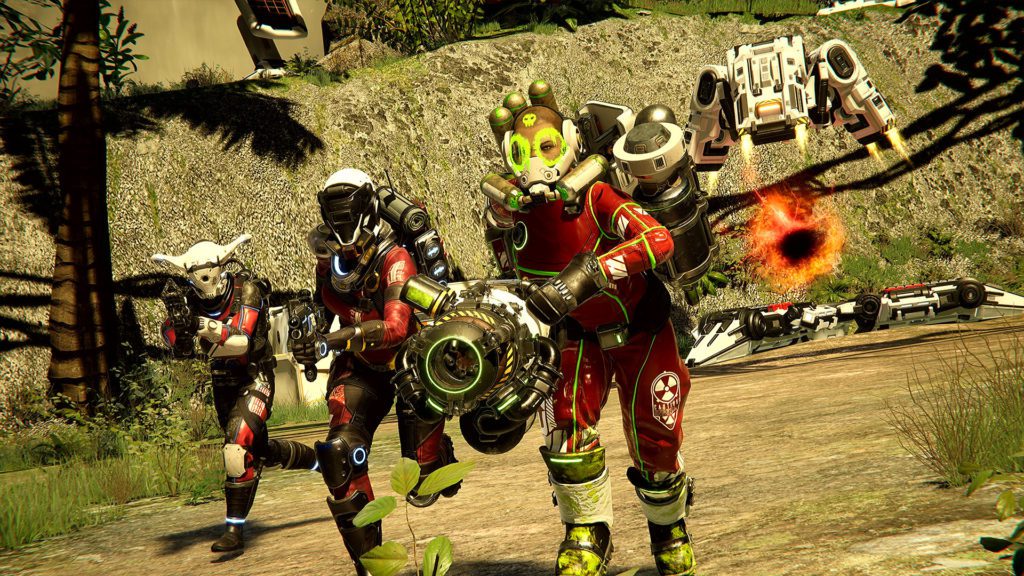REVIEW : Lemnis Gate (PC)
The recent flurry of games based on time loop mechanics shows a simple truth: timefuckery is great, it makes you feel clever, and videogames, with their ties to the concept of eternal death, are the ideal medium for exploring it.
Lemnis Gate resurrects an old-school arena shooter framework and adds a clever time loop concept to the mix. Each match consists of five 25-second rounds that overlap. You choose a different operative for each round to carry out the task, which may be anything from a variant on the conventional Deathmatch, Domination, Attack & Defend modes to capturing orbs from around the map and running them back to your base.

But there’s a temporal twist: you and your opponent’s prior rounds’ plays are looped in with each round—which may be simultaneous with your opponent or turn-based, depending on whatever match type you queue into. As a result, towards the end of the game, you and your opponent are racing about amidst four former versions of yourselves, all of whom are obediently following the paths you’ve laid out for them.
The key to winning is preventing the enemy’s past loopers from completing their objectives while maintaining your own (this is amplified in simultaneous mode, where you and your opponent move at the same time—imagine playing chess with someone!). Of course, shooting an adversary is the most obvious way to cause havoc, but things become a lot more intriguing than that.

Winception
You fly about the battlefield with an observation drone between rounds and during your opponent’s turns. This isn’t some frivolous break; it’s an important planning stage. You can utilise the drone to track particularly annoying foes or to highlight enemy bottlenecks that you can target with a rocket launcher during your turn.
Lemnis Gate becomes increasingly tactical as each round becomes busier and more chaotic as a result of previous rounds’ occurrences. By the final round, you’ve mastered the game, knowing things like how an enemy would appear six seconds into the round through a specific doorway, allowing you to place a mine there in anticipation of his arrival.
Of course, your opponent will be scheming his or her road to success at the same time as you are, and will notice openings that you do not.
Each round introduces a new puzzle. Do you, for example, strive to kill the sniper who is about to kill your Tracer-like speedster who can reach the objective first? Would it be better to employ Karl the robot in the last round to create a protective shield bubble around your previous quick self, preventing that game-changing bullet from ever reaching its target?
Much like chess, finding the proper piece for the appropriate move provides a lot of satisfaction and strategy. Late in the game, I like to use my Vendetta operative (basically an engineer) to muck up the board with three or four of her little turrets that auto-lock onto an adversary that goes by.

The broader arena shooter vibe of Lemnis Gate is bolstered with tight, learnable maps set on interstellar colonies, complete with mobility features like jump pads and a sliding bunny-hops manoeuvre. If Quantum League is the time loop shooter for the Fortnite generation, Lemnis Gate is the time loop shooter for those who grew up on the space stations and asteroid arenas of 1999. The basic weaponset is directly from the Unreal Tournament archives, with replicas of the Link Gun, Translocator teleporter, and even the goo-firing Bio Rifle on hand.
Time-travelling dominoes
The time-looping feature in Lemnis Gate is so ingenious that it makes even mundane FPS ideas like friendly fire more fascinating. On one of my opponent’s turns, they became overly aggressive and killed their orb-carrying buddy with a stray rocket shot in an attempt to wipe out my squad. Instead of killing this berserker on my following move, I rushed off to pick up another orb, return it to base, and then nip back out to pick up the orb he’d graciously abandoned for me.
And, of course, when you die, you’re not precisely dead. If you reach 0 HP, you will continue the round as a ghost, and you can and should continue completing goals and shooting enemies in this state. If you can keep that version of yourself from dying in a future round, they (or is it still ‘you?) might be able to turn the contest in your favour. Players are already employing methods such as murdering a couple of their teammates/past selves with a rocket early in the game, finishing their rounds as ghosts, and then throwing down an orb in a later round to prevent those teammates from dying to the rocket and continuing their loops. It effectively adds more players to the enemy’s team that they weren’t expecting.
This galaxy-brain thing isn’t available in Call of Duty. It’s all kind of brilliant: a game where meticulous planning and pinpointing the enemy’s weak places between rounds can beat out quick reactions. FPS? It’s more akin to FP-Chess.
A heroic exhibition of shooting prowess, on the other hand, can quickly undermine a sound approach. During one round, I was completely outwitted, and by the time the final round arrived, my opponent had destroyed both of the reactors I had done such a poor job of defending. In an attempt to rescue at least one reactor and salvage a draw, I sent out the goo-hurling Toxin, which I succeeded in doing.
With 10 seconds to go, I saw that the loop-trapped opponent would pass by my line of sight for roughly half a second on his way to my other reactor. I foresaw their retreat and hurled a last-ditch glob. It inflicted just enough damage for the Reactor Room turrets to finish them out, which meant my shotgunner defending the reactor would live, which meant the shotgunner would kill the last enemy before they could complete their loop and blast the reactor.
And, owing to the fantastic in-game replay system’s photo option, I can show you that wonderful game-defining moment:

I hadn’t felt such joy in a comeback since my Rocket League glory days, and it’s a tribute to the map design that you can accomplish a lot in just 25 seconds. Lemnis Gate isn’t great, and it’s not just because its name conjures up images of cough medicine rather than 4D Chess with Unreal weapons. It lacks the precision you’d expect from a game where the difference between victory and defeat is so razor-thin. Acceleration and sprinting seem sluggish, hitboxes around heads and shootable targets aren’t always accurate, and the rocket launcher crosshair is a pain to use. It means that, despite all of your great time loop choreography, you’ll have a few moments of hair-tearing anger when your bullet ballets are undercut by a lack of polish. But that testifies to the strong emotions evoked by Lemnis Gate, and these details should be ironed out over time. Overall, it’s a promising start for this high-concept take on the arena shooter, where smart planning between rounds and deft gunplay during them are constantly at odds, and where games may be won or lost on a single bullet, well-placed turret, or—as the case may be—globulet of green goo. Player numbers may be higher, and finding a full 2v2 game may be difficult at this time, but that’s all the more motivation to get in with a friend.
REVIEW : Diamond Hands: To The Moon (PC)













